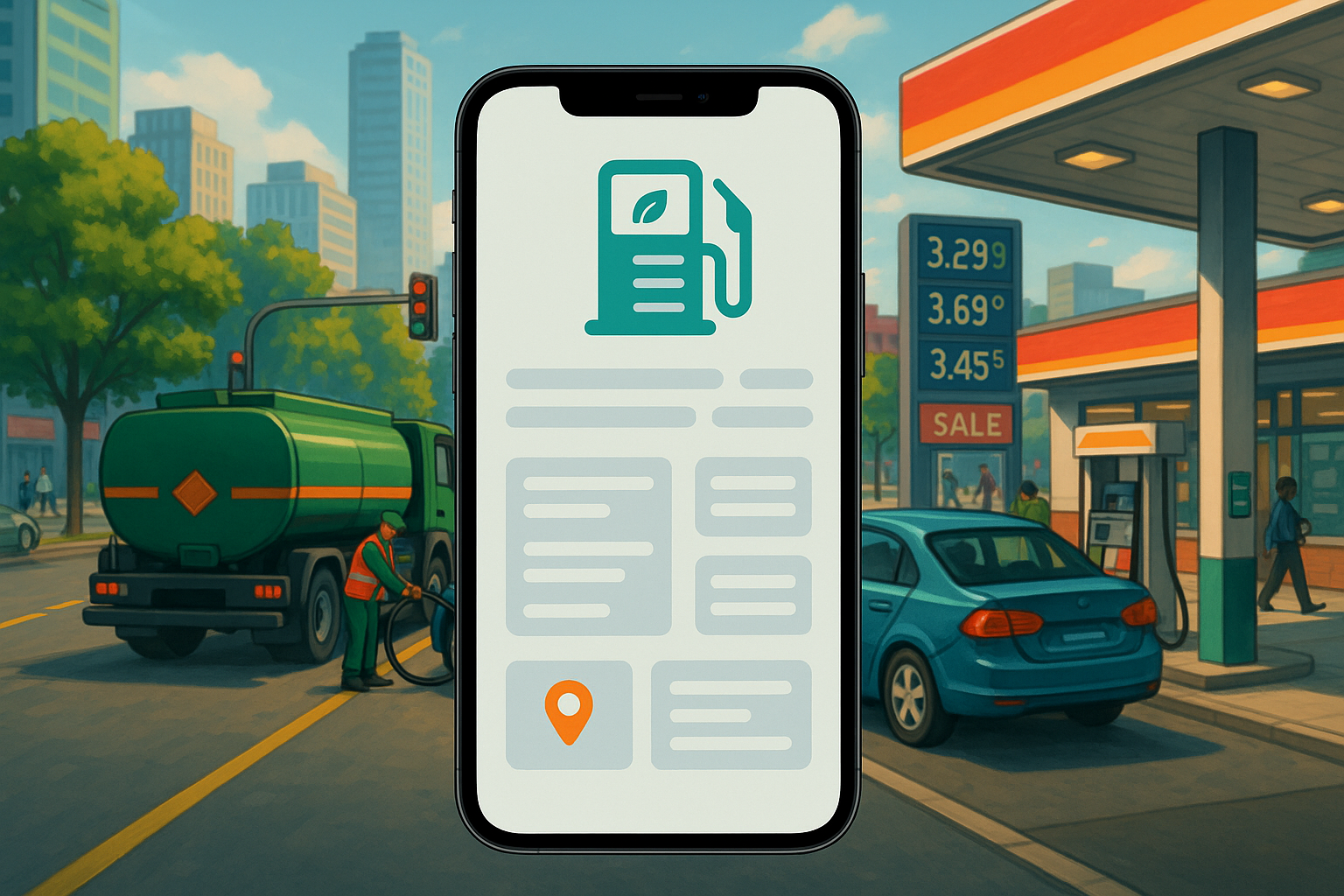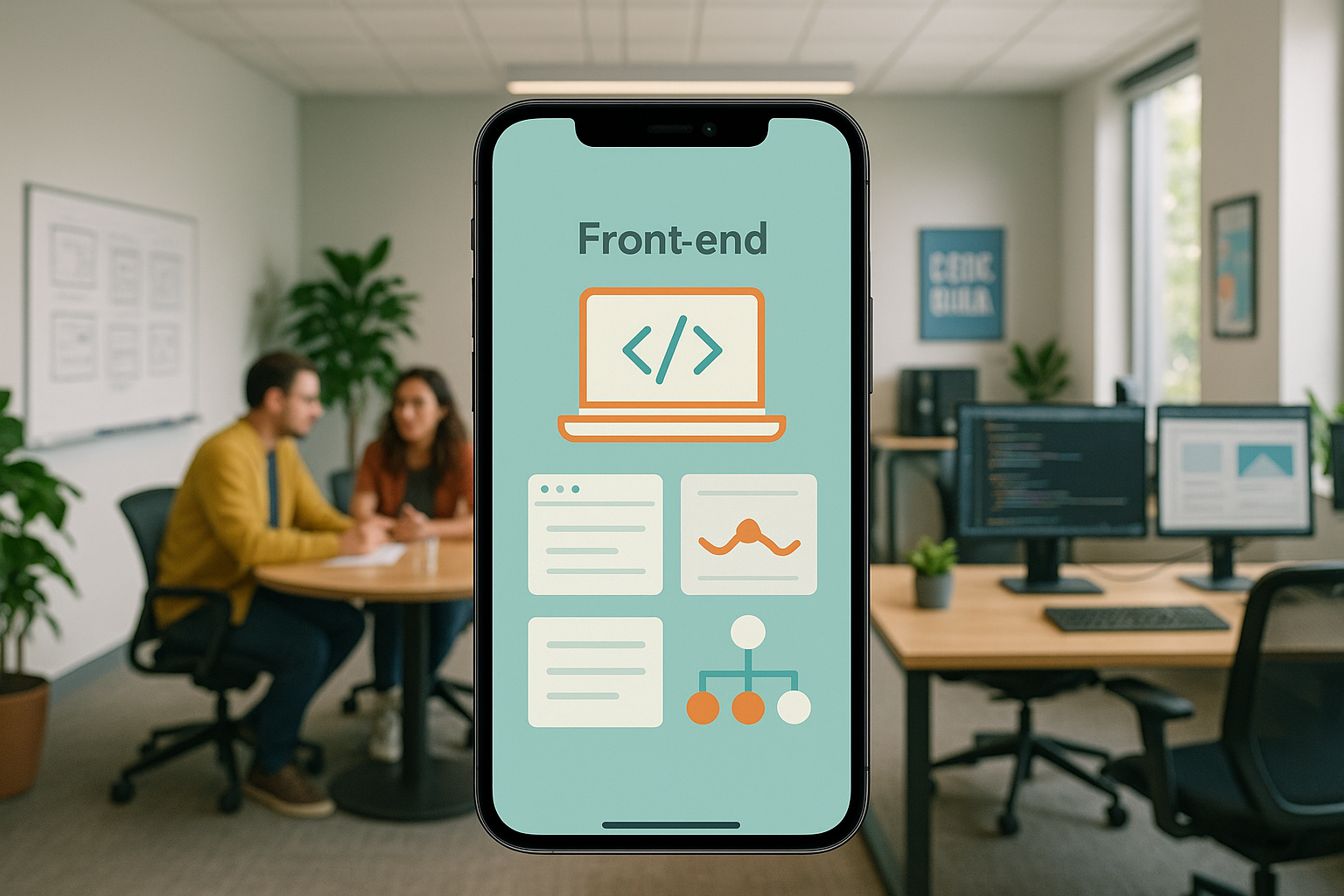The High-Stakes World of Fuel Delivery App Development
The on-demand economy has fundamentally reshaped consumer expectations. We can order food, summon a ride, and schedule home services with a few taps on our smartphones. It was only a matter of time before this wave of convenience reached one of the most routine and often inconvenient errands: refueling a vehicle. On-demand fuel delivery apps promise to eliminate the trip to the gas station, saving users precious time and hassle.
However, developing such an app is not as simple as creating another e-commerce platform. The path is fraught with significant challenges, from navigating a labyrinth of safety regulations for hazardous materials to solving complex logistical puzzles and overcoming substantial technical hurdles. An in-house team without specialized experience can quickly find themselves overwhelmed by compliance issues, supply chain disruptions, and the intricate demands of building a secure, real-time platform.
This article serves as a comprehensive guide to the world of fuel delivery app development. We will explore what these apps are, dissect the formidable challenges of building one, provide a detailed breakdown of the associated costs, and introduce the top development companies that can turn your vision into a reality. As a leading US-based AI-powered app development firm with over 20 years of experience, we at MetaCTO specialize in transforming complex ideas into market-ready applications. We will show you how our expertise can help you navigate these challenges and launch a successful fuel delivery service.
What is a Fuel Delivery App?
At its core, an on-demand fuel delivery app is a mobile platform that allows users to order gasoline or diesel to be delivered directly to their vehicle’s location. This mobile solution creates a seamless bridge between fuel providers and consumers, effectively bringing the gas station to the user and eliminating the need for inconvenient and time-consuming trips. The primary goal is to offer a convenient fuel supply service for everyone, from time-strapped urban professionals to drivers in need of emergency roadside assistance.
By meeting this clear market demand for convenience, businesses can generate new customer acquisitions, improve retention of existing clients, and build a reputation as a forward-thinking, customer-centric brand. In a market increasingly driven by technology, offering an on-demand service creates a pathway for sustainable business growth and a significant competitive advantage.
A robust fuel delivery platform is not a single application but an ecosystem composed of three distinct interfaces, each with features tailored to its user.
Customer App Features
The customer-facing app is the primary point of contact and must be intuitive, transparent, and reliable.
- User-Friendly Interface: The app must be easy to navigate, allowing for simple and quick ordering.
- Real-Time Tracking: Provides transparency and convenience by allowing customers to track the delivery vehicle’s location in real-time and see an estimated time of arrival.
- Seamless Payment Integration: Supports multiple payment options, including credit cards and digital wallets, ensuring secure and effortless transactions.
- Scheduled Deliveries: Allows users to schedule fuel delivery for a future date and time, adding a layer of planning and convenience.
- Fuel Type Selection: Enables users to select the correct fuel for their vehicle (e.g., gasoline, diesel) during the ordering process for precise, customized service.
- Vehicle Information Management: Customers can save details for multiple vehicles (make, model, license plate) to streamline future orders and ensure the right fuel type is delivered.
- Refueling History and Invoices: Gives users access to past orders and invoices for easy record-keeping and expense tracking.
- Push Notifications: Keeps customers informed with order confirmations, delivery status updates, and promotional offers.
Admin Panel Features
The admin panel is the central nervous system of the operation, giving administrators the tools to manage the entire service efficiently.
- Inventory and Delivery Management: Allows administrators to monitor fuel inventory levels and track the status and execution of all delivery schedules.
- Fleet Tracking System: Enables real-time monitoring of all delivery vehicles, helping optimize routes and ensure timely service.
- Customer Management: Maintains a comprehensive database of customer profiles, order histories, and preferences to facilitate personalized service and support.
- Analytics and Reporting: Provides detailed insights into sales performance, customer behavior, and key operational metrics to inform business strategy.
- Dynamic Pricing Management: Allows for the implementation of flexible pricing strategies based on factors like demand, location, and fuel type.
Driver App Features
The driver app empowers delivery personnel with the information and tools they need to perform their jobs effectively and efficiently.
- Route Optimization: Suggests the most efficient routes to customer locations, minimizing delivery times and fuel consumption for the delivery vehicle.
- In-Built Navigation: Provides turn-by-turn GPS navigation to help drivers accurately and quickly reach customer locations.
- Delivery Notifications: Instantly alerts drivers to new delivery requests, cancellations, or changes to their schedule.
- Availability Management: Allows drivers to set and update their work status, indicating when they are available to accept new deliveries.
- Earnings Dashboard: Offers a transparent view of completed deliveries, earnings, and payment history.
Why In-House Fuel Delivery App Development is So Difficult
While the concept seems straightforward, the execution is fraught with complexities that make in-house development a risky and often unfeasible proposition for companies without deep specialization in this niche. The challenges extend far beyond typical software development hurdles.
1. Regulatory Compliance and Safety Hellscape
Fuel is a hazardous material, and its transportation, storage, and handling are governed by a complex web of stringent local, state, and federal laws.
- Navigating a Patchwork of Laws: Regulations differ drastically from one region to another. An app operating in multiple cities or states must comply with each jurisdiction’s specific rules, creating a massive compliance burden.
- Safety Standards: Companies are responsible for ensuring their entire operation adheres to all applicable safety standards. This involves everything from the design of the delivery vehicles to the training of the drivers and the protocols for handling spills. Failure to comply can result in severe penalties, legal liabilities, and irreparable damage to the brand’s reputation.
2. Extreme Logistical and Supply Chain Complexity
A fuel delivery app is as much a logistics business as it is a tech company.
- Maintaining a Stable Supply: The business’s viability depends on a constant, reliable source of fuel. This supply chain is vulnerable to disruption from hazardous events, political instability, strikes, and economic volatility, which can lead to shortages or delays.
- Real-Time Delivery Coordination: Customers expect to know precisely when their fuel will arrive and track its progress. Implementing a flawless real-time tracking and dispatch system that combines GPS, mapping technology, and inventory data is a significant technical challenge.
3. Advanced Technical and Security Hurdles
Building a secure and scalable platform requires a high level of technical expertise.
- Secure Transactions and Data: The app must process payments and handle sensitive user data (names, addresses, vehicle information). Ensuring these transactions are secure and that user data is protected from breaches is a non-negotiable responsibility that requires advanced security architecture.
- Route Optimization and AI: Basic routing is insufficient. To be profitable, the system needs sophisticated route optimization algorithms, potentially powered by AI, to minimize driver time and fuel consumption. Developing and integrating these systems is a complex endeavor.
4. Overwhelming Operational Burdens
Beyond the technology, the day-to-day operations present their own set of challenges.
- Driver Recruitment and Retention: Finding, training, and retaining qualified and trustworthy drivers is a constant challenge. The business must also devise a competitive compensation structure to keep drivers motivated.
- Building Customer Trust: Convincing customers to trust a new service with their vehicles and the delivery of a hazardous material requires a concerted effort to build a brand synonymous with safety, reliability, and professionalism.
Hiring an experienced development agency like MetaCTO mitigates these risks. We have over 20 years of experience building complex, secure, and scalable mobile applications. Our team handles the entire technical lift—from architecting a secure backend to integrating sophisticated logistics and payment systems—allowing you to focus on your core business operations. Explore our Custom Mobile App Development services to see how we can build a solution tailored to your unique needs.
The Cost to Develop a Fuel Delivery App
Developing a fuel delivery app is a significant investment, with costs influenced by a multitude of factors, including feature complexity, design intricacy, technology stack, and the development team’s location. Below is a detailed breakdown of the potential costs.
Estimated Cost by App Complexity
The scope of your project will be the biggest determinant of the final cost.
| Complexity | Total Estimated Cost | Description |
|---|---|---|
| Basic | $30,000 - $60,000 | A Minimum Viable Product (MVP) with core features: user registration, fuel ordering, basic real-time tracking, and payment processing. |
| Medium | $82,000 - $135,000 | Includes all basic features plus scheduled deliveries, multiple payment options, advanced analytics for the admin panel, and an earnings dashboard for drivers. |
| Advanced | $135,000 - $220,000+ | A feature-rich app with AI-powered route optimization, dynamic pricing, predictive analytics, advanced security, and comprehensive third-party integrations. |
Cost Breakdown by Development Stage
The development process is multi-faceted, with each stage contributing to the overall cost. The following table provides cost estimates for an app of medium complexity.
| Development Stage | Estimated Cost Range |
|---|---|
| UI/UX Design | $10,000 - $15,000 |
| User App Features | $15,000 - $30,000 |
| Admin Panel | $10,000 - $20,000 |
| Driver App | $12,000 - $20,000 |
| Backend Development | $35,000 - $50,000 |
| QA and Testing | $5,000 - $10,000 |
| AI Integration | $10,000 - $20,000 |
Hidden and Ongoing Costs
The budget doesn’t end at launch. It’s crucial to factor in ongoing and often overlooked expenses.
- Maintenance and Updates: Expect to spend 10-15% of the initial development cost annually on bug fixes, server maintenance, security updates, and feature upgrades. This can range from $5,000 to $15,000+ per year.
- Licensing and Regulatory Fees: Obtaining operational licenses, insurance, safety certifications, and ensuring regulatory compliance can add 6%-12% to the total cost.
- Marketing and Launch: A successful launch requires a dedicated marketing strategy, which can add 10%-15% to your development budget.
- Scalability: As your user base grows, you’ll need to invest in backend infrastructure, cloud hosting, and load balancing to handle the increased traffic. This can add another 5%-10% to the development cost.
How to Reduce Development Costs
While a quality app requires investment, there are smart ways to manage your budget.
- Start with an MVP: Launching a Minimum Viable Product (MVP) with only the core features allows you to test the market, gather user feedback, and attract investors before committing to a full-featured build. This approach can reduce initial development costs by up to 40%. At MetaCTO, we specialize in this approach with our Rapid MVP Development service, getting you to market in 90 days.
- Outsource Development: Outsourcing to cost-effective regions can lower development costs by 30%-50%. However, it’s vital to choose a partner with a proven track record to avoid sacrificing quality.
- Choose the Right Tech Stack: Opting for cross-platform development using technologies like React Native or Flutter allows you to build for both iOS and Android simultaneously, reducing costs by 25%-40% compared to native development for each platform.
- Leverage Pre-Built Solutions: Using pre-built modules or APIs for functionalities like payments or maps can reduce development time and costs by 20%-30%.
Top Fuel Delivery App Development Companies
Choosing the right development partner is the single most important decision you will make. You need a team with the technical expertise, industry experience, and strategic vision to navigate the complexities of this niche.
1. MetaCTO
As a premier US-based AI-powered mobile app development agency, we at MetaCTO are uniquely positioned to build, grow, and monetize sophisticated applications. With 20 years of experience, over 120 successful projects launched, and more than $40M in fundraising support for our clients, we don’t just build apps; we build businesses.
What sets us apart for fuel delivery app development is our deep expertise in handling the very challenges that make these projects so difficult.
- AI and Machine Learning Integration: The future of logistics is AI. We excel at integrating advanced AI solutions, from the dynamic route optimization and predictive analytics mentioned in the cost breakdown to custom machine learning models that can forecast demand. Our AI Development services can give your platform a decisive competitive edge.
- Robust and Scalable Architecture: We build apps designed for growth. Our team architects secure, scalable backend systems that can handle the complexities of fleet management, inventory tracking, and a growing user base without a hitch.
- Expertise in Complex Integrations: From secure payment gateways to third-party logistics APIs and mapping services, we have a proven track record of seamless integrations that are essential for a smooth user experience.
- Strategic MVP Development: We champion the 90-day MVP model. We help you validate your idea, launch quickly to gather real-world data, and build a solid foundation for future growth and investor confidence, all while managing your budget effectively.
2. JPLoft Solutions Pvt Ltd
JPLoft is a prominent web and app development company known for delivering a wide range of solutions across more than 70 countries. They have built a strong reputation for providing budget-friendly services without compromising on quality.
- Key Strengths: JPLoft highlights its massive project portfolio (1100+ delivered), a high client retention rate (97%+), and significant cost savings for clients (up to 60%).
- Service Model: They offer flexible engagement models, including fixed cost, hourly, and monthly arrangements, along with a strict non-disclosure agreement to ensure client confidentiality.
- Positioning: JPLoft is an excellent choice for businesses looking for a reliable, high-volume, and cost-effective development partner, particularly those comfortable with outsourcing to the Asian market. Their extensive experience makes them a capable contender in the fuel delivery app space.
Conclusion: Fueling Your Success with the Right Partner
The journey to launching a successful fuel delivery app is both exciting and challenging. The service offers immense value to consumers and a lucrative opportunity for businesses willing to innovate. As we’ve detailed, the development process involves much more than just coding; it requires a masterful orchestration of regulatory compliance, logistical planning, robust security, and an intuitive user experience across three distinct platforms.
The costs can be substantial, and the potential pitfalls—from supply chain disruptions to security breaches—are significant. This is why attempting to build such a complex system in-house is a high-risk endeavor. The key to success lies in partnering with a development firm that possesses not only the technical prowess but also the strategic foresight to navigate this demanding landscape.
At MetaCTO, we bring over two decades of experience in building sophisticated, AI-driven mobile applications. We understand the intricacies of creating secure, scalable, and user-centric platforms that solve real-world problems. From validating your concept with a rapid MVP to integrating advanced AI for operational efficiency and scaling your app for growth, we are with you every step of the way.
If you are ready to bring the convenience of on-demand fuel to your customers, don’t go it alone. Talk with an expert at MetaCTO today to discuss how we can build a powerful fuel delivery application that drives your business forward.






